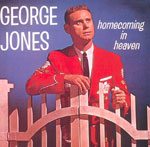
"He Made Me Free" (Track 2, "George Jones: Homecoming in Heaven," 1962, United Artists; re-released, Razor & Tie, 1995) To listen to a part of the song, click here
Over his career, George Jones has made about half a dozen gospel albums. This one, released in 1962, and "The Best of Sacred Music," from 1971, are the best of the bunch. What is particularly interesting about "Homecoming in Heaven," is that rather than being made up of standards like "Old Brush Arbors" and "I'll Fly Away," it consists of mostly contemporary sacred music by such songwriters as J. P. Richardson (better known as the Big Bopper, who died in the same airplane as Buddy Holly) and Willie Nelson (who wrote the title track). There's hardly a dud.
Certainly not this tune by Jones' boyhood pal and frequent songwriting collaborator Darrell Edwards, who has three songs on this album. Both Jones and Edwards learned their craft in the country churches of East Texas, near the border with Louisiana. Their understanding of the form is very apparent. Most gospel attempts to immediately capture the listener, then travel along with him as it builds to a crescendo — almost a moment of ecstasy. And that's true with "He Made Me Free." Though the lyrics are a somewhat clichéd litany of a man's redemption, it's a great melody and, in Jones' hands, a minor masterpiece.
|
Why George Jones? Matt Diebel explains here. Past Gems: |
This song, as well as some others on the disc, also shows him departing from the closed-mouth, clenched-jaw style which has become his trademark. And the full-throated Jones is a glorious thing to behold. It's almost as if, in the studio, he's transported back to that wooden church where he was taught to let it all hang out. Of course, he brings to it a few tricks he has learned in the 20 years in between — phrasing, soaring notes, contrasting emotions. If you believe, as I do, that George Jones' 1962–65 stint with United Artists brought the best-recorded albums of his career, then this is the best-produced of all. Spare to the point of spartan, it has virtually no trickery — just a little bit of reverb — and ace musicianship (is that pedal steel master Buddy Emmons, a frequent session player for Jones, on some of the tracks?). It is yet another of the fine Jones discs rereleased by Razor & Tie, a New York City–based outfit that has wisely chosen most of its Possum material from the United Artists years. You can still find it at an Internet store near you.
